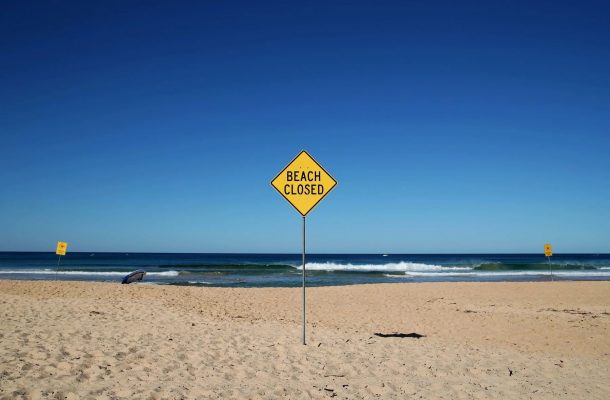The end of an open Australia?

One of the defining characteristics of the world we inhabit has been a marked increase in global mobility that most of us thought was here to stay. However, the COVID-19 crisis has brought much of the world to a standstill.
As the pandemic unfolds, it’s clear that the steps taken to combat the virus have ramifications for almost every facet of life as we know it. Recent articles published on Monash Lens discuss the impact of the “new normal” in terms of increased vulnerability to family violence , gambling and cybercrime, as well as shifts in religious practice, to name just a few.
In this contribution to the COVID-19 debate, I consider how border controls and other measures to limit human mobility have featured in the response to the pandemic, and speculate about possible longer-term implications for a differently bordered world.
Fighting the enemy without
In the early days of the crisis, the federal government turned to border control mechanisms that were usually reserved for asylum seekers arriving by boat, such as offshore detention, to quarantine travellers returning from China. Medical authorities criticised this extreme distancing measure as unnecessary and risky on health grounds, citing the historical use of the facility as a place of intense “trauma and anguish”.
Those familiar with Australia’s harsh treatment of asylum seekers might speculate that the real reason for this policy response may have been a desire to legitimise the costly reopening of the Christmas Island Immigration Detention Centre. Indeed, subsequent arrivals from virus-affected areas were successfully accommodated on the mainland, including the use of five-star hotels.
Some Australian citizens confined to comfortable hotel rooms reportedly complained of being treated like “ prisoners and refugees”. While this comparison is questionable, political rhetoric has sometimes revealed similarities in the underlying principles driving both policy areas.

The Minister for Health, Greg Hunt, sought to reassure the Australian public they were being protected by a “ ring of steel” around Australia through its border. These words were borrowed directly from the lexicon used previously to describe border defences erected to prevent the arrival of refugees.
As the list of countries hardest hit by the virus began to expand, travel bans such as those imposed on China were swiftly put in place to prevent arrivals from Iran. South Korea, with much higher levels of infection at the time, escaped the stricter controls. Eventually, South Korea and Italy were added to the list, but not before much less restrictive controls had first been implemented for arrivals from Italy.
The revelation that the Minister for Home Affairs, Peter Dutton, had brought the virus with him on a flight from the United States underlined the complete failure to introduce additional controls on arrivals from that emerging hotspot.
Although these restrictions applied to place of embarkation rather than nationality, the unexplained inconsistencies invite the conclusion that factors other than risks to public health were influencing policy decisions.
Country-based perceptions of risk are deeply embedded in Australia’s risk-based visa system, whereby citizens of “high risk” countries face extra checks before being awarded visas. Iran, a country that has produced high numbers of asylum seekers, is a key example.
Ultimately, a comprehensive shutdown of the national border to all but Australian citizens and residents, regardless of their place of embarkation, obscured the selectivity that had characterised the early approach to stopping COVID-19 at the border.

The construction of personalised borders
As the number of infections continued to rise, questions were asked about whether the focus on preventing the virus crossing the external border was detracting from efforts to stop community-based transmission. Testing regimes that were slanted in favour of testing overseas arrivals potentially reinforced the view that the main threat arises from outside Australia’s borders.
Eventually, recognition of the threat posed by community transmission led to the imposition of strict physical distancing rules around the country, designed to curtail the mobility of all Australians.
This policy created borders of a different kind. When Queensland’s Chief Health Officer, Jeannette Young, announced the tightened stay-at-home measures in her state, she likened them to “putting a border at the front of every person’s door”.
As many Australians have objected to being confined within their own homes, urgent calls are being made for the release of immigration detainees in order to safeguard their wellbeing and manage the spread of the virus.
To ensure compliance with the self-isolation requirements on those known or suspected to be infected, state police were first tasked with monitoring door-to-door. In response to the imposition of wider restrictions, police powers have been extended to authorise the use of fines and move-on directions for this purpose in public places. Victoria has established a 500-strong squad dedicated to enforcing coronavirus measures.
Early cases of overreach, and wider civil liberties concerns in relation to these new functions, have been reported. But few Australians would be aware that police in every state were already empowered to enforce border controls directed towards non-citizens, as designated officers under the Commonwealth Migration Act 1958.
The emergence of state borders
As the failure to control the spread of the virus at national level became evident, states have begun to take control of their own borders. In Queensland, the sight of traffic tailing back from the NSW border, as police staffed hastily erected border checkpoints, was a novel sight on the television news.
Perhaps not surprisingly, the island state of Tasmania had been the first to impose border controls, believing it was well-placed to contain the virus at the border. Later, the West Australian government announced its intention to turn itself into “an island within an island” by closing off traffic from the eastern states.

Not content with controlling mobility at state level, some regions are demanding intra-state controls, hoping to quarantine their populations from outsiders. Four federal members from northern Queensland have reportedly petitioned state Premier Annastacia Palaszczuk to establish a border dividing the north and south of that state.
Rural communities around Australia have followed suit, expressing a desire to prevent movements into their areas from cities, where infection rates are high.
Concerns about the possible spread of the virus to Aboriginal communities led to proposals from the Northern Territory government to restrict mobility into communities. Similar measures were requested by APY communities in remote parts of South Australia.
At the same time, requests for state assistance to move vulnerable elders out of the APY lands and closer to medical facilities in Adelaide were denied, inviting comparisons with the longstanding control over the mobility of Aboriginal people by the state.
What the future might hold
Border control, both external and internal, has featured strongly in Australia’s response to the threat of the coronavirus, supplemented by other novel means to control human mobility. The purpose of this article has not been to critique those responses, but to draw attention to the ubiquity and fluidity of borders in their many guises.
Contrasts and parallels have also been noted in relation to the much harsher regimes of control to which asylum seekers have long been subjected. It’s taken a crisis of unprecedented proportions to bring into sharp relief the reach of border control into the precarious lives of people living without the full protections of citizenship.
Looking more broadly, the COVID-19 pandemic has elicited soul-searching on a global scale, about whether rapid changes in how we communicate and interact, the expectations we place on government to promote our welfare, and how we care for the environment, might translate into a “new normal” that extends beyond the crisis.
“Not content with controlling mobility at state level, some regions are demanding intra-state controls, hoping to quarantine their populations from outsiders.”
Historian Yuval Noah Harari has recently written about how emergencies such as the current global pandemic “fast-forward historical processes”. I think we can feel that we’re living that reality now.
Speculating about what sort of world might emerge beyond the pandemic, he suggests that we have two choices: between “totalitarian surveillance and citizen empowerment”, and between “nationalist isolation and global solidarity”. While these possibilities are perhaps overly stark, we can glimpse each of them playing out in the processes of re-bordering and border enforcement described here.
Several years ago, I asked authors contributing to an edited book, Rethinking Border Control for a Globalising World, to engage in a thought experiment in which they imagined a “preferred future” of “relaxed borders”. In this imagined world, some kind of bordering might persist, but the harms currently perpetrated in defence of national borders would be a thing of the past.
This exercise in speculation was a considerable challenge for social sciences steeped in the interpretation of empirical data. Rather than indulge in a utopian dream, I asked them to identify the fundamental changes in material conditions that would create the necessary conditions for a differently bordered world.
Despite all the difficulties and upheavals we’re now living through, and the retreat we see into the perceived safety of borders, I still hold out hope that those conditions could start to emerge at the other end of the crisis.
This article was published by Lens.
Leanne Weber is an Associate Professor of Criminology at Monash University in Melbourne. She researches border control, policing and migration policing using criminological and human rights frameworks.











